March 7 - 13, 2021: Issue 486
Lynleigh Greig: 2021 Pittwater Woman Of The Year
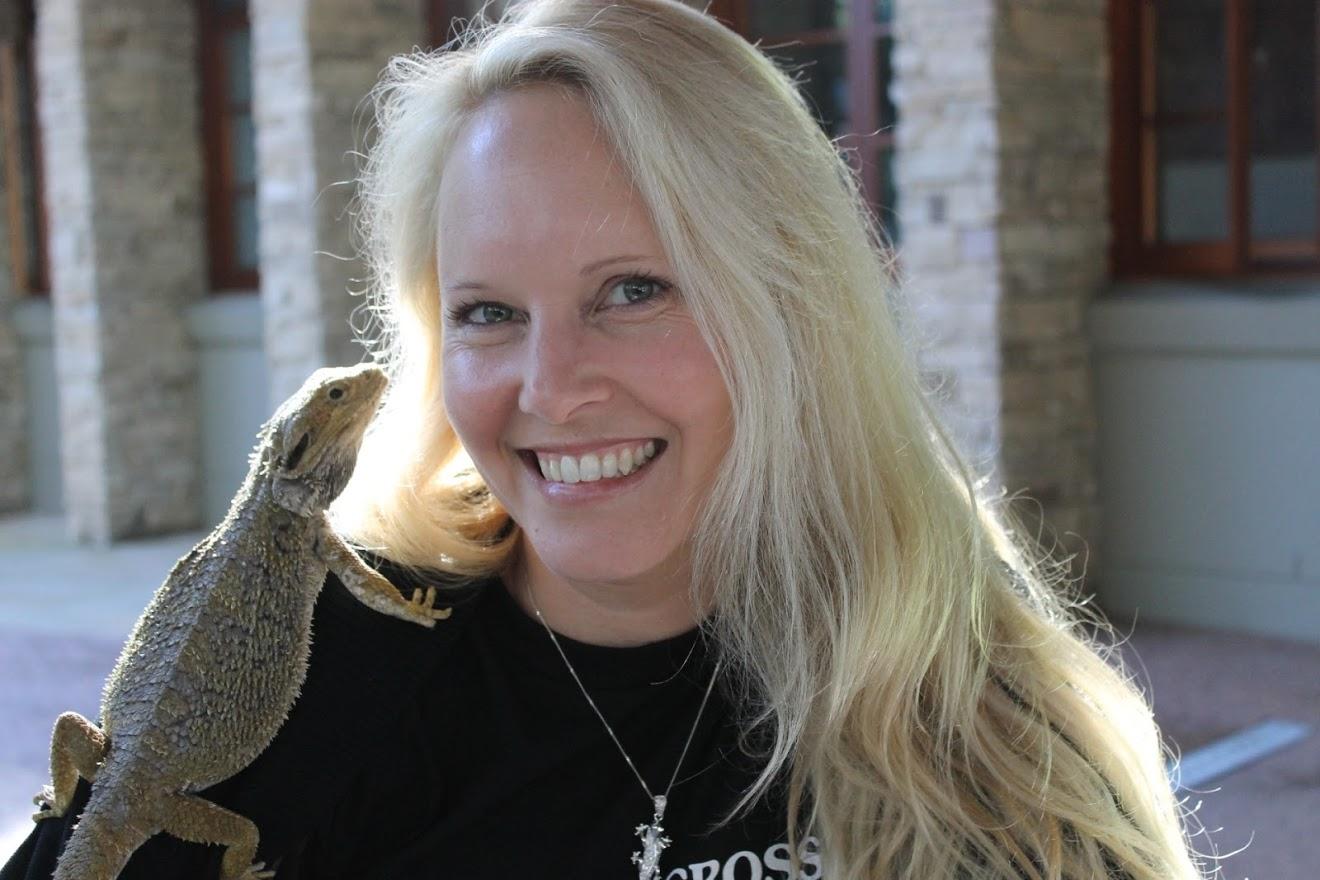
On Wednesday March 3rd Member for Pittwater Rob Stokes announced wildlife rescuer Lynleigh Greig as the 2021 Pittwater Woman of the Year.
The award was announced at the annual Zonta International Women’s Day Breakfast, at Royal Prince Alfred Yacht Club, and recognises outstanding achievements of local women and their valuable contribution to the Pittwater community.
Over the past 10 years Lynleigh has volunteered countless hours supporting injured and vulnerable wildlife, including during the 2019/20 catastrophic bushfires across NSW. Lynleigh has also been instrumental in establishing Sydney Wildlife Rescue’s mobile care unit, which provides deployable treatment in emergency situations.
“Lynleigh is a passionate advocate for our native wildlife and is widely regarded for her fearlessness and expert knowledge,” Rob Stokes said.
“Many locals have called upon Lynleigh when faced with snakes, possums, lizards and other types of uninvited wildlife in their homes.
“Lynleigh has an encyclopaedic knowledge of wildlife and has an enviable ability to calmly wrangle, rescue and relocate those creatures that make many of us squirm.
“In a community like ours that’s fortunate to be surrounded by bushland and national parks – wildlife volunteers like Lynleigh are invaluable.
“Lynleigh’s enthusiasm, knowledge and approachability is evident to everyone that’s sought her assistance and seen her at work.
“The role Lynleigh and other volunteers performed in the aftermath of the fires was particularly important and has directly benefited our state’s wildlife recovery.
“This award is a fitting recognition of Lynleigh’s enormous efforts and ongoing contribution to our community,” Rob Stokes said.
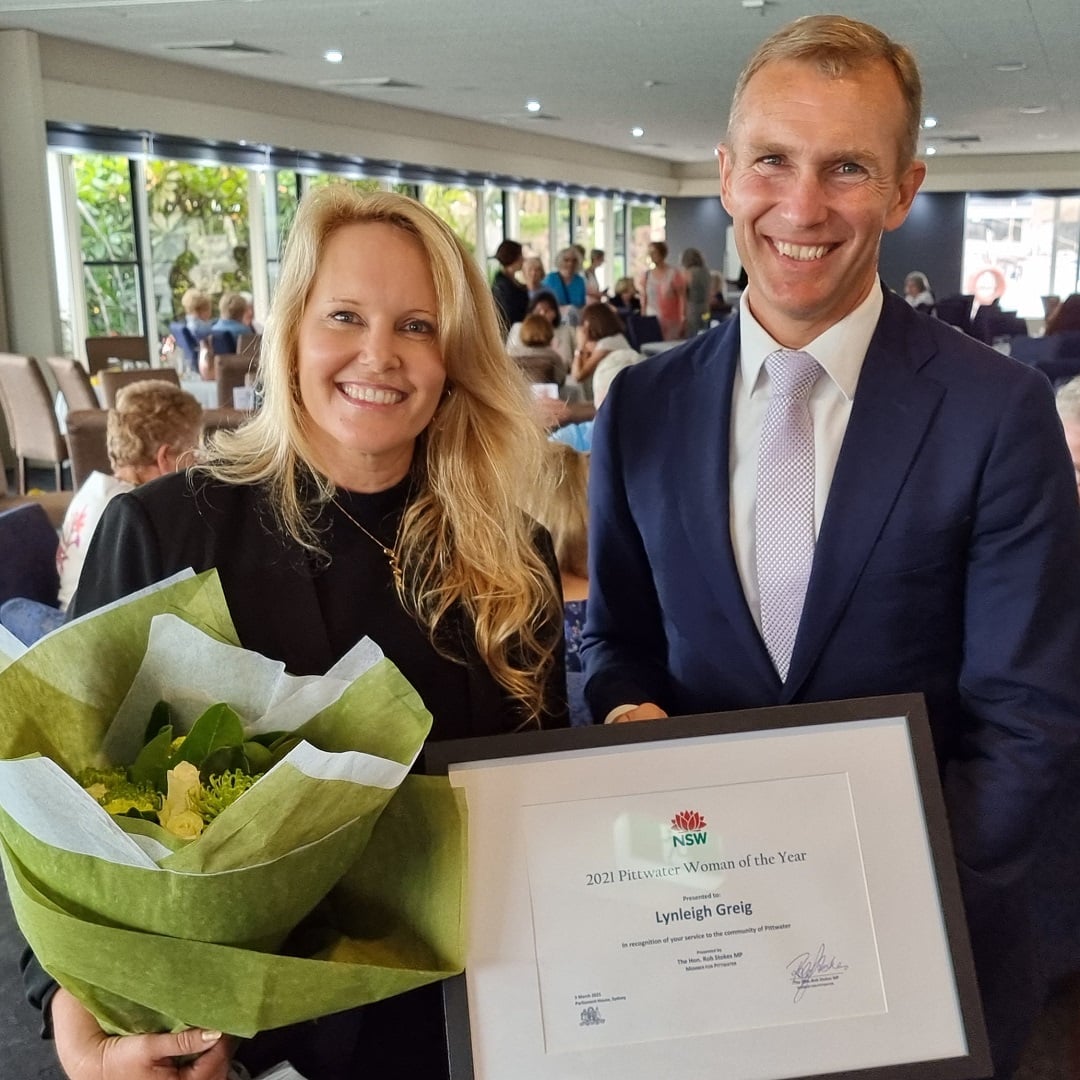
Lynleigh and Rob Stokes, MP for Pittwater
Many long-term Readers will have read some of the articles and reports Lynleigh writes for Pittwater Online News over the years. Every form of wildlife that can be found here has featured at one time or another. More than that, Lynleigh has also run timely information for when snakes emerge, or when newly fledged birds may be found out of nests. Lynleigh's information on how to check the pouches of mothers of wildlife hit by cars on our roads for young frequently is revisited.
Lynleigh's work as a volunteer wildlife rescuer goes beyond sharing her knowledge and experiences though. She is in demand speaker at schools and for local organisations, gets her hands in the dirt to help maintain facilities at the Sydney Wildlife Waratah Park Rehabilitation centre, trained to become a reptile handler, trained to become on of those licensed to dart macropods as part of rescues, has been and continues to be an articulate speaker when media focus on the plight of our wildlife comes into focus, particularly during the 2019/2020 bushfires, then throws on a spiffy dress to host fundraisers to support the work of wildlife carers; the medicines needed, the facilities that need an upgrade or even to be built.
One of the larger projects, launched with fellow Sydney Wildlife volunteer Joan Reid, was to buy and fit out a Mobile Wildlife Clinic. Lynleigh, supported by a great group of Sydney Wildlife volunteers and ringing in some 'names' ran a series of Galas and Garden events at the home of long-term supporters, Sue and Peter Glasson, until that goal was reached.
In the Spring of 2019, Lynleigh sent in a report about fitting out the van. Then came the fireball Summer of 2019-2020 and the horrific impact this had on our wildlife in the firegrounds.
On Saturday January 11th 2020 the Sydney Wildlife Mobile Care Unit drove down Booralie Rd in Terrey Hills bound for the South Coast to provide veterinary assistance to fire-affected and burnt wildlife.
This was the van’s ‘maiden voyage’ so it was very special for the wildlife carers and veterinarians travelling with them to enjoy some community spirit with a great send off. There was a convoy as along with the van, 6 volunteer veterinarians, 3 volunteer rescuers, 3 kangaroo joeys and a few media crews went with them. The wonderful veterinarians volunteering on this trip were Dr Margot Horder, Dr Caroline Woods and Dr Nandita Kataria - all from Collaroy Plateau Veterinary Hospital; Dr Izi Sladakovic from NVS/AVES in Terrey Hills; Dr Kathleen Graham from Kellyville Veterinary Clinic; and Dr John Thirlwell and Kimberley Moore from Belrose Veterinary Hospital. Full report in: Sydney Wildlife Mobile Clinic's Inaugural Run Into The New South Wales Firegrounds Has Been Supported By The World's Leading Wildlife Organisations and Carers: January 2020
The emotional impact on all the wildlife carers the team went to help, along with that team itself, was devastating. The physical strain, which went on for months, is hard to understand for those outside of this field.
Becoming a wildlife carer is a little alike becoming a new mum with 2am and 5am and 11pm feeds - only this goes on for as long as you are caring for an animal, and in the Greig household, sometimes there are a variety of 'critters' that need attending to - dressing wounds, giving medicines, feeding. It's a 24 hours 7 days a week job. If you want time off you have to find someone who can step in and undertake that work load.
Then there's those that don't make it, or make it and then pass away unexpectedly. Lynleigh's report on the much loved Cloudy still brings many to the point of anger over how careless human beings are around other animals while others are simply reduced to tears, over and over.
It's not for the faint hearted - you have be strong willed, resilient, determined, and ultimately, have a very big hearted.
Pittwater Online News spoke to one of our longest serving 'columnists' after her award this week - one of the few instances we have had to ask the questions for quite some time.
How does it feel to be named Pittwater Woman of the Year?
Gobsmacked, incredulous, thrilled, flabbergasted…. I definitely feel unworthy but also very grateful that people see value in what wildlife rescuers do for the community. The Award is absolutely a team-win for the whole of Sydney Wildlife Rescue and for everyone who is doing their bit to protect and care for our wildlife. Coincidentally, it happened to be World Wildlife Day on the day of the event so it was very fitting that the wildlife were honoured on their special day.
I was treated like a Rock Star at the beautiful Awards Breakfast and all the Zonta Club ladies were just divine! What a warm and welcoming group of women doing amazing things! Some of my favourite Councillors and local MPs were in the crowd and I could feel them beaming up at me when I took to the stage. To think that the Hon. Rob Stokes and his worship the Mayor, Michael Regan, and so many other amazing people decided I was worthy has given me a gargantuan cranium so watch out for my big head ha ha ha 😊
The Sydney Wildlife Mobile Care Unit – a huge project realised. How did this begin and what did it take until it was actually responding to events?
The Mobile Care Unit was the brainchild of my fellow-volunteer and friend, Joan Reid. Once Joan came up with the concept of a mobile unit that was to be set up for the care and treatment of wildlife only, we started our campaign to make it happen.
Joan Reid and Lynleigh Greig, October 2020
It took us 3 years to raise the funds through a number of Fundraising Events (including a couple of garden parties at the wonderful Glassons’ home and a glitzy Black Tie Gala at the Cardinal’s Palace in Manly). Once we had raised enough money, we went shopping for a Jayco van! Of course, the entire internal part of the van needed to be repurposed for wildlife treatment so we had the bed ripped out, the toilet removed, the cupboards rearranged, a treatment table installed and we set about getting diagnostic equipment of every kind to help our volunteer veterinarians to offer the best possible treatment to our patients. Much of the diagnostic equipment was donated by Worldwide Veterinary Services, the treatment table was donated by Mona Vale Veterinary Hospital, many of the medications were supplied by Troy Laboratories, Northside Veterinary Services in Terrey Hills, Mona Vale Veterinary Hospital and Collaroy Plateau Veterinary Hospital. The beautiful external decor was done by Pivot Creative in Cromer using the exquisite images taken by photographer extraordinaire, Peter Sharp of Tame and Wild Studio. The images are of actual patients that have been treated and released by Sydney Wildlife Rescue. Many of the interior modifications have been done by the wonderful Tony Philps of the Belrose Lions Club (he also co-manages the Mens Shed in Belrose). The Mobile Care Unit was nearing completion when the heinous 2019/2020 fires flared. In the lead-up to our first deployment to the South Coast fire grounds, we had volunteers swarming all over the van, readying it for its first trip and ensuring it was set up for triaging badly burnt and injured animals. It was a crazy time!
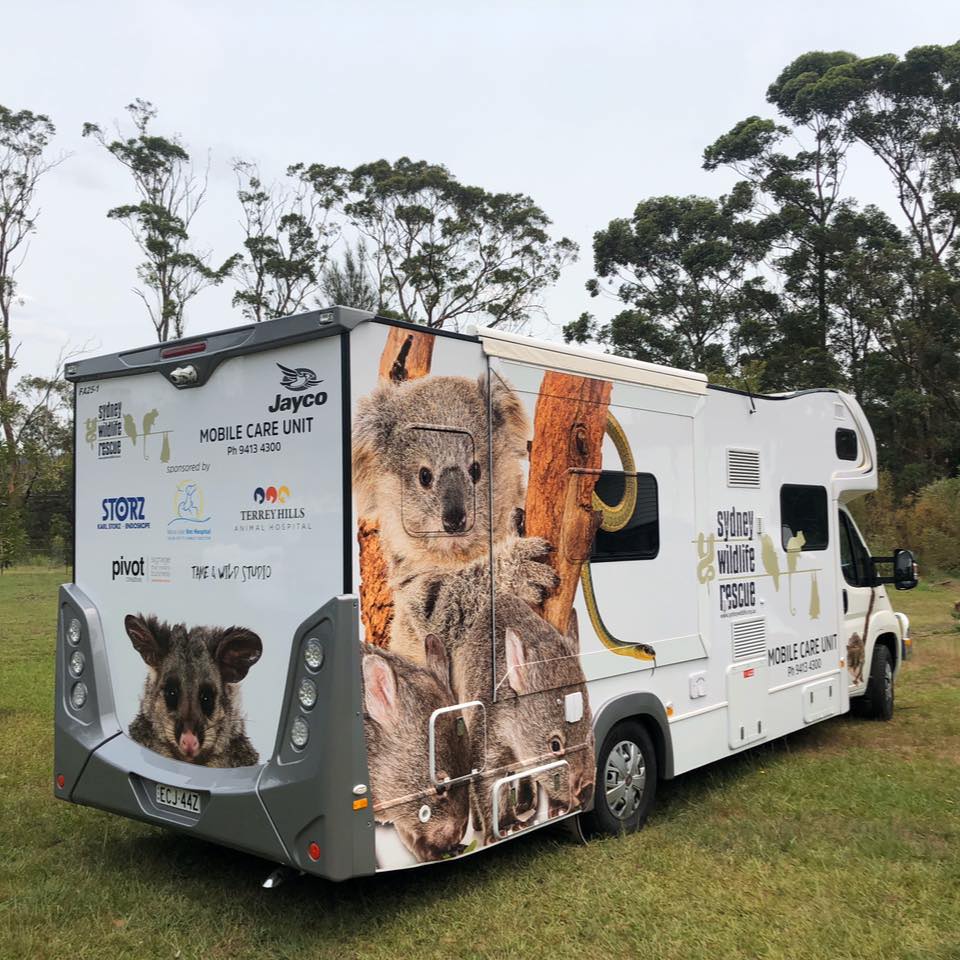
On the 11th January 2020 a small but determined group set off at 6 o'clock in the morning. 3 rescuers, our head veterinarian (Dr Margot Horder) and 3 kangaroo joeys travelled in the van and 5 other volunteer veterinarians and staff followed in convoy. Our destination was Wandandian on the South Coast where we set up camp at the property of Wildlife Rescue South Coast volunteer, Adrina Selles. On our first day in the fire grounds, our volunteer veterinarians treated a multitude of wildlife - everything from wallabies, kangaroos and wombats to lorikeets, echidnas and even a beautiful tiger snake! We also took the van into the Blue Mountains fire grounds as well as the Cooma region, where we joined forces with Vets for Compassion and HUHANZ from New Zealand who had set up triage centres and were treating many fire victims already. We had Search and Rescue Teams out in the field who were searching for survivors, darting them for assessment in the field and then getting runners to bring back the injured ones to the van and triage centres. We did this for months until the Covid pandemic took over. We now run regular ‘clinic days’ outside the Coastal Environment Centre in Narrabeen, with the permission of the Northern Beaches Council. We are so grateful for their support! Carers book appointments and bring their sick, injured or orphaned wildlife to our volunteer vets for examination and treatment. Our team is a marvel! We are a very tight knit and cohesive group doing amazing things for wildlife 😊
How long have you been involved as a Volunteer in Sydney Wildlife?
I joined Sydney Wildlife Rescue nearly 10 years ago. I started out rescuing about 1 animal a week and now it’s about 4 a day! The team at Sydney Wildlife Rescue is truly inspirational - from the dedicated office volunteers who take calls 24 hours a day, 365 days a year to the team in the field, doing the hands-on rescuing - we like are a family that cares not only for the wildlife but for each other.
Please share an overview of a typical month as a Sydney Wildlife volunteer:
One of the difficulties of being a wildlife rescuer is that you have no idea what your day will hold! It could start at 6am with a call-out to rescue a wallaby jumping around in traffic on the Wakehurst Parkway and end at 10pm with a call-out to a venomous snake caught in netting. And you could spend the rest of the day driving the streets of Duffy’s Forest searching for a kangaroo that was reported to be injured or trying to capture a pelican with fishing line around its leg. Every day holds multiple surprises! We often find that beautiful sunny days are the ones we dread the most as they seem to yield the most rescues. Rainy days can mean a slight lull in call-outs - certainly in terms of reptiles.
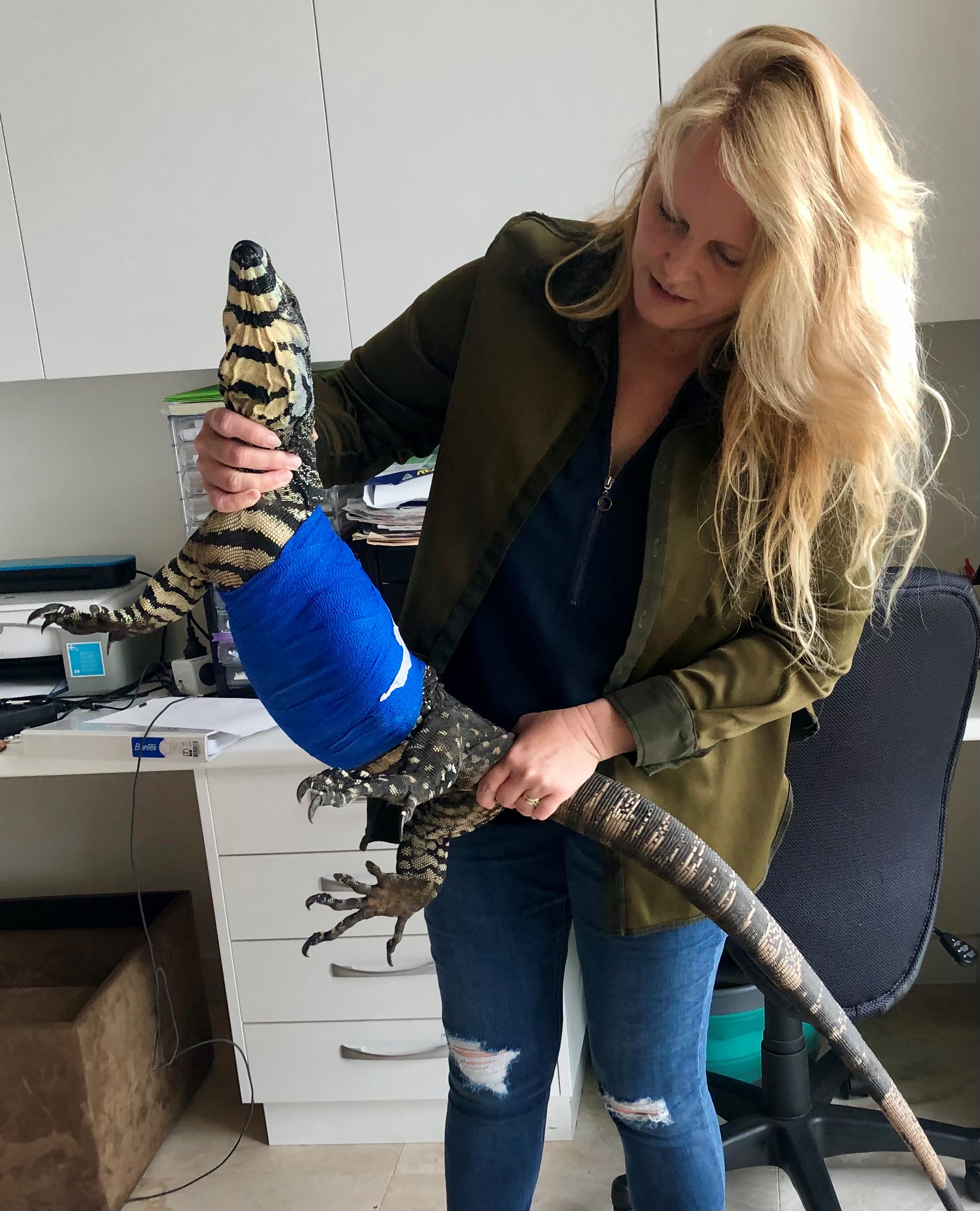
Rescued - February 2021
One week can consist of 4 rescues every day and another week can consist of one 1 rescue every third day. We just never know what to expect.
One thing is very constant, though...
Poo.
Poo features in every day. Multiple times a day. And from many different sources. I clean up a LOT of it! And when you are hand-raising joeys or baby birds, poo is something that you scrutinise for signs of ill-health or brewing issues.
I usually have a minimum of 16 animals in my home at any one time so there is never a day with nothing to do. At the moment I have an eastern brown snake, 2 red-bellied black snakes, a very large lace monitor, a ringtail possum, a turtle, 2 bearded dragons, a water dragon, a marsh snake, a green tree snake, a golden-crowned snake and a multitude of pythons and blue-tongued lizards. The feeding, cleaning and treatment schedule is a full-time job in itself. But you have to be prepared to drop everything to rush to an urgent rescue at any time.
Every Thursday is spent in our Sydney Wildlife Mobile Care Unit which we park outside the Coastal Environment Centre in Narrabeen. The day starts at 7:30am when Joan Reid and I head up to collect the van from its usual home and drive it down to Narrabeen. We then spend an hour getting the water and electricity plugged in, getting the equipment out and ready for use and setting up our ‘reception area’ at the front of the van. We often have 3 veterinarians on duty as we can have 12+ patients per day. Our amazing team - Dr Margot Horder, Dr Izi Sladakovic, Dr Lou Matthews, Susan, Margaret, Joan and I - are often joined by ophthalmic veterinarian, Dr Kath Graham and physical rehab specialist, Fran Wilcox. And no Thursday is complete without a pop-in from Anne Jackson - founder and manager of Medi-Divert - as she brings us all manner amazing medical supplies.
In addition to rescuing, caring, running the Mobile Care Unit, lobbying for better protection for wildlife and writing Grant applications, we also undertake community education. Schools, pre-schools, retirement homes, companies, clubs and organisations often request to have talks about wildlife and their habitat. We enjoy doing these as it galvanises people to do positive things for wildlife.
On any given month we are also planning and running courses for our volunteers - bat courses, venomous snake handling courses, baby possum courses etc. Planning and executing these courses takes a lot of time and resources.
Every month is different and can vary with the seasons. Spring, for example, is a crazy time with baby animals popping up everywhere, reptiles emerging from brumation (winter dormancy) and people moving about more with the warmer weather which increases wildlife-human interactions. Some rescues happen in areas which have boat-access only. Some rescues happen in dangerous locations. Some rescues occur in adverse weather conditions.
Only one thing is certain in the life of a wildlife rescuer - the knowledge that we can make a difference to an animal’s quality of life.
How can people support this work?
If you love what we have achieved and would like to support our work, please visit www.sydneywildlife.org.au where you can either donate to the Mobile Care Unit or join as a volunteer (see upcoming training courses). The Sydney Wildlife Mobile Care Unit has a GoFundMe account set up as well: https://www.gofundme.com/f/22abqws
If you find an injured animal in need, please contact us on 9413 4300 - any time of the day or night and any day of the year.
Extracts From Lynleigh's 2014 Profile (Issue 166):
The lady who is a regular contributor of articles and reports on looking after all our Australian wildlife has the kind essence you wish you could bottle and share around. As someone recently remarked about Lynleigh and her fellow Sydney Wildlife carers: “thank the Good Lord for such amazing, compassionate and caring people. I have so much admiration for you all as I know how much dedication, patience and commitment it takes!”
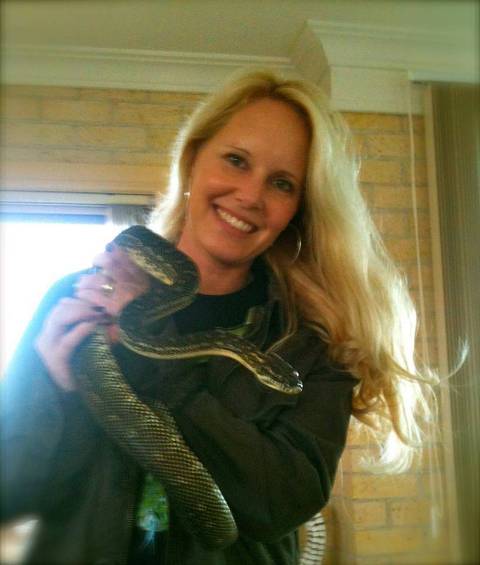 Kind, considerate, considered by many as the ‘poster girl’ for SW, not just because of her dedication and input and showing a beauty on the inside that ranks with her outer loveliness, but because Lynleigh does deliver; she will go out in the community and give Wildlife Educational Talks and Demonstrations and it is Lynleigh we’ve met when attending working bees, garden tools in hand or greeting people at the door of fundraisers.
Kind, considerate, considered by many as the ‘poster girl’ for SW, not just because of her dedication and input and showing a beauty on the inside that ranks with her outer loveliness, but because Lynleigh does deliver; she will go out in the community and give Wildlife Educational Talks and Demonstrations and it is Lynleigh we’ve met when attending working bees, garden tools in hand or greeting people at the door of fundraisers.
In early June 2014 Lynleigh was in Hobart attending the Wildlife Rehabilitators Conference, this week more work out in the community doing her utmost to share information on the devastating impact we are all having on our native wildlife and how everyone can do something to shift us in the opposite direction. Add to that a home filled with critters she is carer for while they rehabilitate, two wonderful children and a supporting husband who join her in this work and you get a glimpse into a 24/7 life that’s bursting at the seams with…well, life!
When and where were you born and what was your life like while growing up?
I only have 5 pairs of shoes. Snake-catching boots, thongs, runners, winter boots and horribly uncomfortable high-heels for fancy functions. Unlike most women, shoes don’t interest me at all. They were pretty much optional when I grew up in Zimbabwe (which was still called Rhodesia when I was born back in 1972).
I had a fantastic childhood – mostly because I was blissfully oblivious to the fact that we were in the middle of a Civil War!
I thought it was normal to travel in convoy to avoid being attacked by terrorists and that everyone’s father was called up to serve in war… The country was crippled by sanctions imposed by the UN and we had petrol rations, food rations and went for months without luxuries such as chocolate. But I didn’t know any different and thought that sleeping overnight in the car in the “petrol queue” was a huge adventure…!
We lived on a relatively large property that comprised of a fairly ordinary 3-bedroom, 1-bathroom house but an adventure filled wonderland of a garden. We had the perfunctory rolling lawns directly off the verandah but from there, the garden got interesting… Right in the middle of our land was a huge monolithic rock – bigger and taller than our entire house and riddled with niches, caves, nooks and crannies. There was an orchard of fruit-trees at the bottom of the property, a chicken-run, a grape-vine along one fence and areas of rock outcrops with ‘wag-a-bietjie’ thorn-bushes (which literally means ‘wait-a-minute’ thorn bushes – which is what you have to do when you get caught up in them!) The servants’ quarters were in the far left-hand side of the property, just beyond the mango trees. We had a house-servant called Naison who was an ex-boxer (his face was cross-stitched with scars) and we had a garden helper called Madala (which means ‘very old’). In many countries, having servants is taboo. In Rhodesia it was perfectly ordinary.
My sister (Gail) and I spent countless hours clambering over the rock outcrops, monkeying up the trees, guzzling fruit from the orchard and running around like bare-footed hooligans. We often pretended to be undercover spies deeply embedded in espionage and ‘spied’ on our neighbours, taking down comprehensive notes about their every move. Our two chowchow dogs were often transformed into valiant steeds in a game of Cowboys and Indians and we sometimes built fairygardens, had picnics on the giant rock and incessantly pestered all the little bugs and critters that we encountered on the property. We were animal-mad from the very beginning. So were both our parents. Many little creatures haplessly wandered into our lair – tortoises, squirrels, blue-headed lizards and the odd cobra. We never harmed any of them – rather, we pestered them with cuddles and love (except the snakes which we just observed from a reasonable distance).
We were both entranced by snakes, though, and they became our favourite animal.
People often ask me why I love snakes so much. I think my sister and I both became obsessed with them after a rather unfortunate incident in our early childhood. Our parents had taken us to a plant nursery on the outskirts of town. We adored the nursery with its myriad plants, flowers, ferns, shrubs. We played hide ‘n’ seek together amongst the ferns and hid our plastic toy soldiers among the trees for each other to ‘find’. On this particular day – whilst playing - we spotted a magnificent rinkhals (a type of venomous snake in Southern Africa) slithering through the leaf-litter. He was beautiful.
He was just going about his business, not harming a soul. We watched him – enthralled. Then suddenly a shovel-wielding worker slammed him in the head repeatedly, with such force that all his innards flew into the air and into our hair. We screamed and screamed! People thought we were screaming because we were afraid of the snake, but we were screaming because of the sheer injustice of what had happened to that poor, innocent creature…
From that day onwards, an unspoken pact to educate people about snakes seemed to take hold of us both.
Gail is now a snake-handler and Eco-tourism officer at Blydepoort in Southern Africa. I rescue and relocate snakes (and other wildlife) here in Australia.
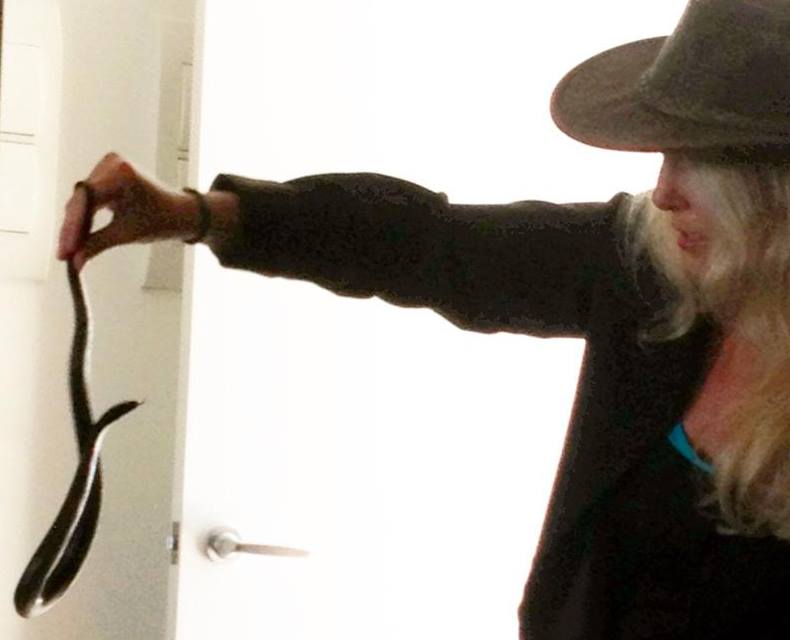
Lynleigh with a snake
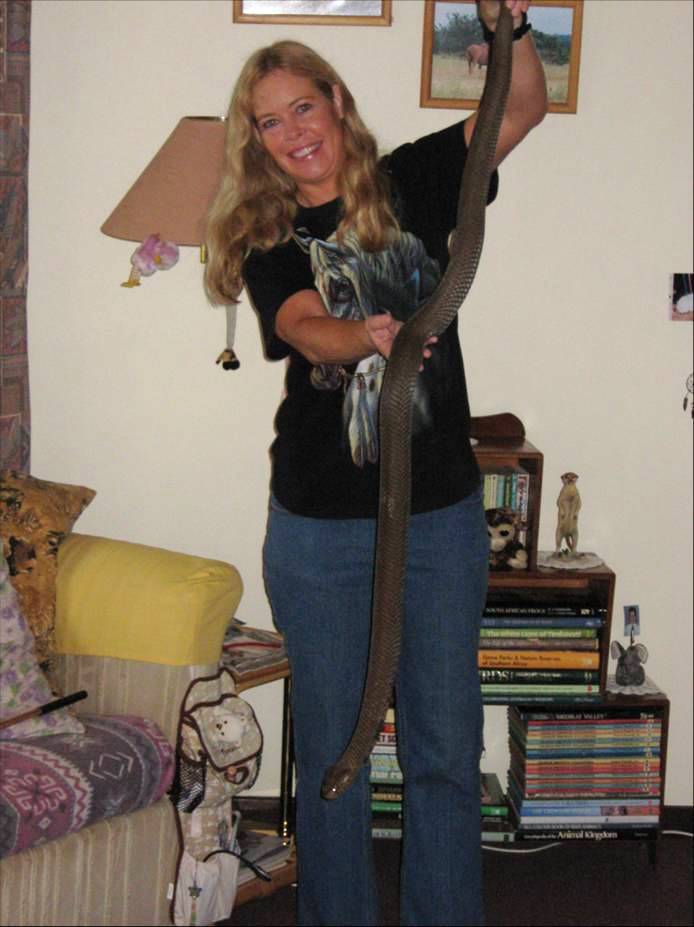
Gail with one of her snakes
When did you move to Australia ?
My husband and I moved to Australia 17 years ago, shortly after getting married. We’d been childhood sweethearts from the age of sixteen. Both our children – Connor (13) and Kayleigh (11) were born in Sydney and have always held Australian passports. Connor is an Aussie through-and-through and supports the Wallabies in the rugby. Kayleigh, however, believes she’s African. She even speaks Zulu! She’s so much like my sister and has inherited the snake-loving gene, too. For her seventh birthday she asked for a pet snake and Scayleigh the Spotted Python has been a much-loved member of the family ever since.
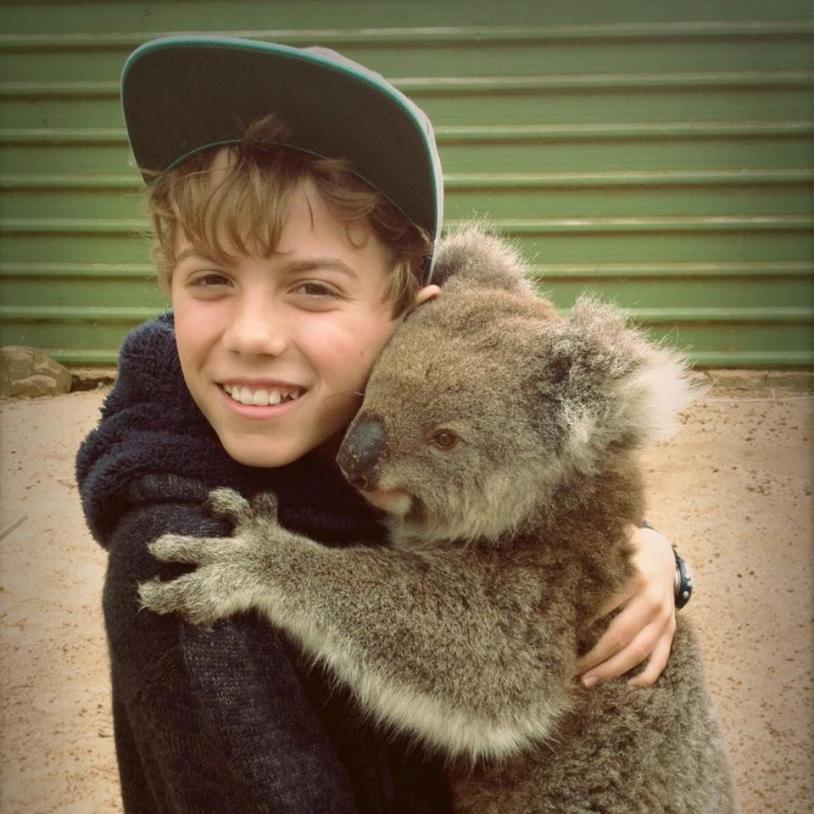
Connor
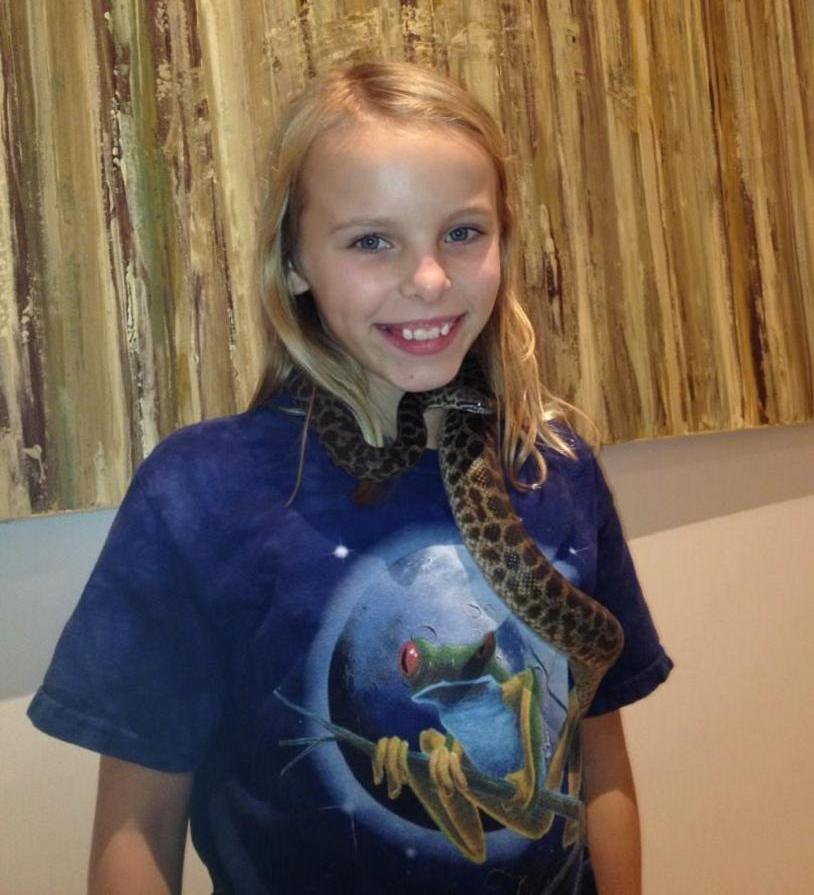
Kayleigh
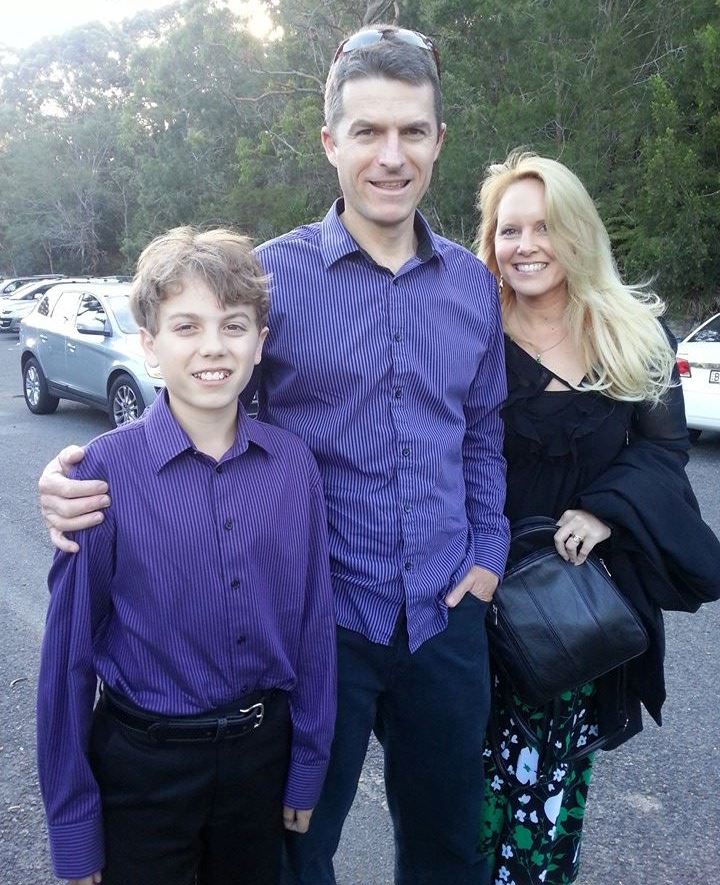
Kayleigh taking the picture - from 2014
You are known as ‘the poster girl’ for Southern Cross Wildlife Care and not only curate and write Sydney Wildlife articles for here but also do a fair amount of hands on caring 24/7 – please describe the range of animals people call you to attend - ...
Knowing that I love animals, many of my friends would ring me if they found a snake in their backyard or an injured possum on the road. After undertaking many ‘unofficial’ wildlife rescues, I decided it would be wise to do a course and become a volunteer wildlife rescuer. In November 2011 I became a very proud member of Sydney Metropolitan Wildlife Services (Sydney Wildlife) after completing their Basic Rescue and Care Course. I couldn’t wait to sign up for the Venomous Snake Handling Course which took place 2 months later. By December of that year, I was licensed to handle any Australian snake and I couldn’t wait to do my first rescue!
Since that day I have done more rescues than I could possibly count. It surprises me how often our poor wildlife find themselves in strife – mostly caused by humans in some way.
Habitat loss, collisions with vehicles, attacks by domestic pets, entanglement in fishing line etc. One night I was called to a kookaburra rescue. The poor bird had hit a vehicle and was still caught in the grill of the car… She needed a miracle…!
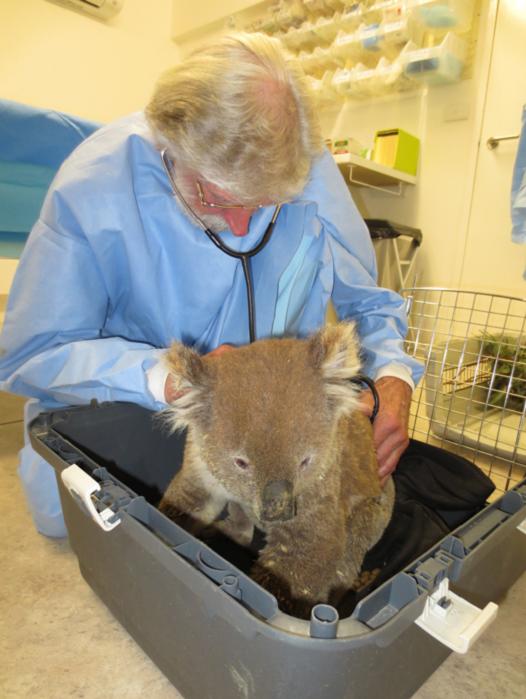 And that miracle came in the form of Dr Howard Ralph. I knew veterinarians were special, but he was just super-human.
And that miracle came in the form of Dr Howard Ralph. I knew veterinarians were special, but he was just super-human.
Dr Ralph is a retired veterinary surgeon who – along with his devoted wife and a small group of volunteers – spends his every waking hour saving wildlife – on a 100% voluntary basis! He started Southern Cross Wildlife Care 5 years ago in order to provide veterinary services to rescued wildlife. I started volunteering for Southern Cross Wildlife Care the moment I walked in with the kookaburra – I had never seen such dedication to the welfare of wildlife! I knew I wanted to be a part of it!
The beauty of being a volunteer for both organisations is that Sydney Wildlife is a rescue group and Southern Cross Wildlife Care provides veterinary care to rescued wildlife. The two organisations go hand-in-hand. Perfect for me!
Wildlife rescuing is NOT for the faint-hearted…! At most rescues you are dealing with many aspects: an unfamiliar location, a panicked member of the public, a scared and injured animal, maybe dangerous weather conditions…
One of my wildest rescues ever started with a call-out to the North Head Water Treatment Facility. The underground workers had encountered a large black snake tangled in some cables and were reluctant to continue work until it had been removed. On arrival, I was issued with a special permit to enter the underground facility. I was provided with high-visibility clothing and a hard-hat and was lead through two sets of heavy metal doors and into an elevator. Only two floors were marked on the elevator: “Bat Cave” and “Hell” - both more than 60m underground…! Faced with the choice between “Bat Cave” and “Hell”, which would you choose?
We alighted from the elevator and it was easy to see why it was called The Bat Cave… Low arched ceilings of blasted rock were inches from my head. Hot air swirled around and the sounds of dripping water and whooshing air surrounded me. I’ll admit – I was creeped out… The snake was the least of my concerns! I followed the duty-manager down through the warren of tunnels and eventually came to another heavy metal door with a huge step-up into a control room of some kind. The workers were standing back and pointing to the snake under a workstation. It was very dark and it took my eyes some time to adjust enough to see the black snake… He’d managed to get entangled in computer cabling. It was tricky as he was positioned just above an open grate. If I were to disentangle him and drop him, he’d fall through the open grate. All the aspects of a difficult rescue were present: an unusual underground location, panicked workers, a scared animal, dangerous conditions involving wiring.
It was a tricky rescue and my hand was often inches from the snake’s mouth. There were a few heart-stopping moments… But I finally managed to get him free and bag him – after which everyone in the room applauded! We nicknamed the snake “Hades” due to his close proximity to “Hell” ha ha ha.
Some of our rescues involve removing baby joeys from the bloodied bodies of their dead mothers, killed by cats or dogs or cars. If the babies are relatively unscathed, we begin the arduous undertaking of becoming their adoptive Mums. It’s wonderful but exhausting… The babies often require 3-hourly feeds – night and day. And they don’t scream for food at night like a human baby; you have to set an alarm to feed them or they’ll just die quietly waiting for you to feed them.
Ringtail possums can take 3 months to reach a stage where they are old enough to be released. Swamp wallabies and kangaroos can take more than 18 months to get to that same stage!
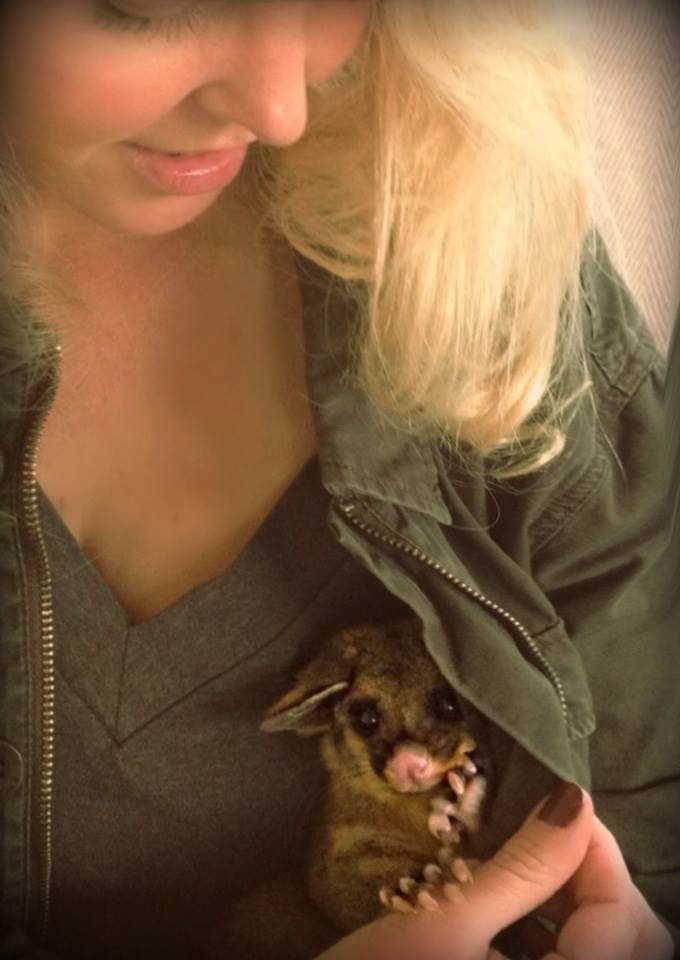
Possum Mum!
You’re also a mum – how do you balance all the work you do as a volunteer for SCWC with running a home and catering to two growing children?
Being a possum-mum can be fun but when you have two human joeys to tend to as well, things can get rather out-of-hand.
Luckily my two kids are every bit as concerned with the welfare of the injured critters as I am. They help a lot – with caring for the animals and often at the rescues as well.
My poor husband also has to cope with things he never imagined having to deal with… Seeing gross food items in the fridge, such as mealworms, crickets and frozen mice (lizard and snake-food). He puts up with having turtles in the bath, baby possums in the bed, snake-surgery on the dining-room table and a car full of rescue equipment and possum-foliage.
Weekends are often spent scouting around for good release sites, building aviaries, cleaning poop out of enclosures or cradling injured or dying creatures. Some days I think it drives him batty but deep down I think he loves that we are making a difference and teaching our kids to be less focused on themselves and more on the world around them.
If you could be a another creature for a day – furred, finned feathered or scale – what would you be and then do?
Recently I’ve done a few raptor rescues. Watching these magnificent creatures in flight makes me think that if I were to be an animal of any kind, I would choose to be a bird of prey: minimal predators, the ability to fly and razor-sharp talons. Great combination.
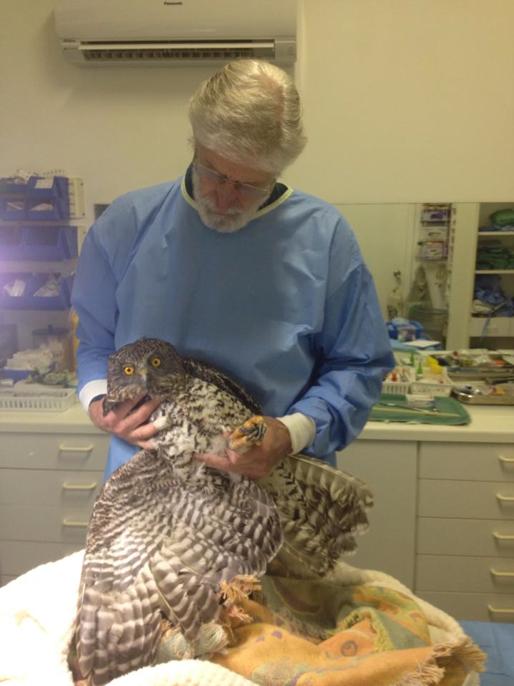
Dr Howard Ralph with a Powerful Owl Lynleigh recently looked after until release back into it's home habitat. See Powerful and Precious by Lynleigh Grieg
What is your favourite place in Pittwater and why?
My favourite place in all of Pittwater is Narrabeen Lagoon. It is the most amazing little microcosm of habitats for every creature imaginable. I love the serenity of kayaking on the lake beside pelicans, black swans and the local resident ducks.
I love watching my kids sailing and my husband wind-surfing – both sports that involve harnessing the energy of the wind. I love to cycle with my family around the lake and stop for coffee at the Boathouse. It’s a wonderful place – full of adventure, wildlife and wistful moments.
What is your ‘motto for life’ or a favourite phrase that you try to live by?
We have a family motto: Vision, Vigour, Love and Laughter.
Each of us brings one of these attributes to the family unit and together we strive for all 4.